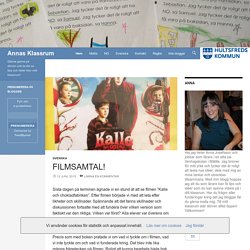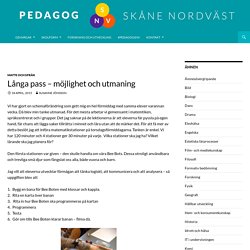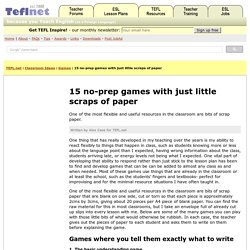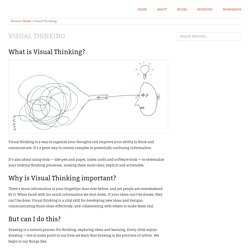

Glänta gärna på dörren och ta del av tips och idéer från mitt klassrum! Vi har jobbat en hel del med En läsande klass-materialet och tycker vi haft stor hjälp av läsfixarna för att förstå och bearbeta texter.

Eleverna har tyckt det varit roligt och snappar snart upp de olika arbetssätten. Vi jobbar också mycket med att skriva texter då Att skriva sig till läsning varit vår läsinlärningsmetod under ettan. Dessa två olika momenten har fungerat mycket väl var och en för sig, men nu var det läge att ta arbetssätten ett steg längre. För några veckor sedan fick eleverna i uppgift att skriva en berättelse till en bild. Instruktionen ni ser nedan, var i stort sett den enda instruktionen de fick. Jag blev mycket positivt överraskad av elevernas texter då detta var bland de första gångerna de skriver helt själva, med penna och med väldigt lite instruktioner. Jag bestämde mig för att jobba vidare med texterna. Vid nästa tillfälle var det dags för parjobb igen. Så resonerade vi vidare genom läsfixarna och skrev på tavlan. Långa pass - möjlighet och utmaning.
Vi har gjort en schemaförändring som gett mig en hel förmiddag med samma elever varannan vecka.

Då blev min tanke utmanad. För det mesta arbetar vi gemensamt i matemtiken, språkcentrerat och i grupper. Det jag saknar på de lektionerna är att eleverna får pyssla på egen hand, får chans att lägga saker tillrätta i minnet och lära utan att de märker det. För att få mer av detta beslöt jag att införa matematikstationer på torsdagsförmiddagarna. Tanken är enkel. Den första stationen var given – den skulle handla om våra Bee Bots. 15 no-prep games with just little scraps of paper. One of the most flexible and useful resources in the classroom are bits of scrap paper.

One thing that has really developed in my teaching over the years is my ability to react flexibly to things that happen in class, such as students knowing more or less about the language point than I expected, having wrong information about the class, students arriving late, or energy levels not being what I expected.
One vital part of developing that ability to respond rather than just stick to the lesson plan has been to find and develop games that can be can be added to almost any class as and when needed. Most of these games use things that are already in the classroom or at least the school, such as the students’ fingers and textbooks- perfect for improvising and for the minimal resource situations I have often taught in. Games where you tell them exactly what to write 1. Give out two pieces of paper per student and ask them to write the two categories you will be looking at on them, e.g. 2. 3.
33 Digital Tools for Advancing Formative Assessment in the Classroom. I came across a great blog post the other day – Formative Assessments Are Easier Than You Think – that told the firsthand account of a teacher, Steven Anderson, who implemented formative assessment in his classroom.

He used a sticky-note version of an exit ticket to elicit evidence of student learning and in his words, “what a difference that made.” Formative assessment is ‘easier than you think’ and with all the digital tools and apps now available for mobile devices it’s even easier. We’ve shared some digital tools before and with the five tools that Steven shared combined with our earlier suggestions there are now 33 digital tools that we’ve uncovered that are free or inexpensive and help teachers implement formative assessment in their classrooms. Here they are: A few of Steven’s discoveries: Lino – A virtual corkboard of sticky-notes so students can provide questions or comments on their learning.
Poll Everywhere – Teachers can create a feedback poll or ask questions. Pick Me! Create and share visual ideas online. Icebreakers: free instructions to the best games and activities. Visual Thinking. What is Visual Thinking?

Visual thinking is a way to organize your thoughts and improve your ability to think and communicate. It’s a great way to convey complex or potentially confusing information. It’s also about using tools — like pen and paper, index cards and software tools — to externalize your internal thinking processes, making them more clear, explicit and actionable. Why is Visual Thinking important? There’s more information at your fingertips than ever before, and yet people are overwhelmed by it. But can I do this? Drawing is a natural process for thinking, exploring ideas and learning. “I’m no artist” “I can’t draw a straight line” “I can’t draw a stick figure” This is a fallacy. Don’t believe me? Visual Thinking basics In this 20-minute video I share some basics of visual thinking that will get you up and running in about 20 minutes. How to know what to draw. Visual thinking.
Visual thinking is a way to organize your thoughts and improve your ability to think and communicate.

It’s a way to expand your range and capacity by going beyond the linear world of the written word, list and spreadsheet, and entering the non-linear world of complex spacial relationships, networks, maps and diagrams. It’s also about using tools — like pen and paper, index cards and software tools — to externalize your internal thinking processes, making them more clear, explicit and actionable. Why is visual thinking important? There’s more information at your fingertips than ever before, and yet people are overwhelmed by it. When faced with too much information we shut down. We think in pictures.